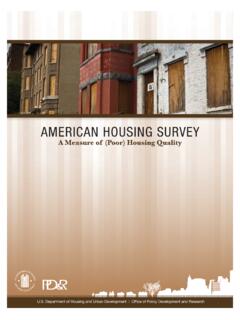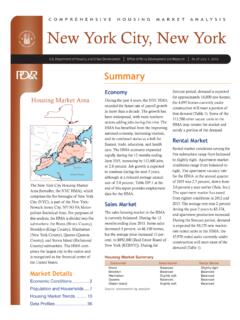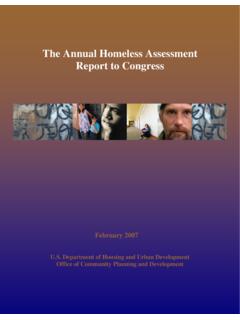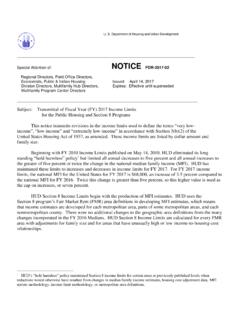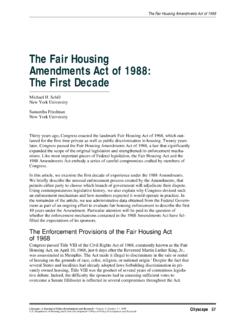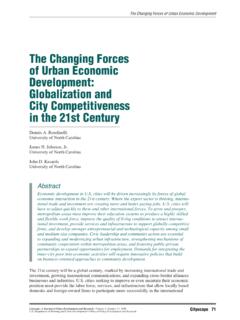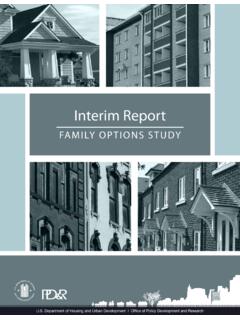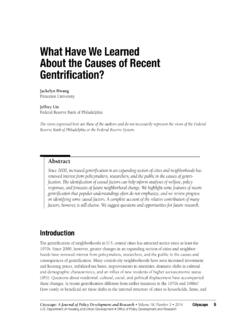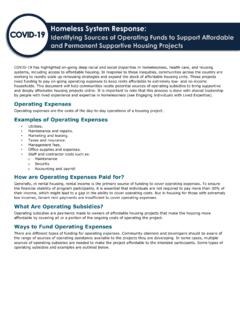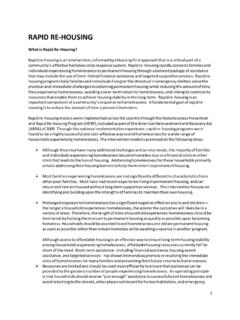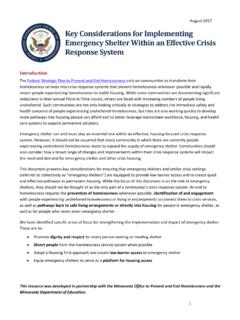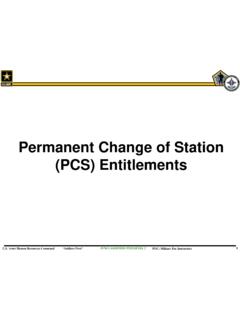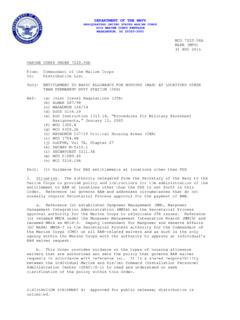Transcription of Understanding Encampments of People Experiencing …
1 Understanding Encampments of People Experiencing Homelessness and Community Responses: Emerging Evidence as of Late 2018 January 7, 2019 Submitted by: Rebecca Cohen Will Yetvin Jill Khadduri Abt Associates pg. i Table of Contents List of Exhibits .. ii Introduction .. 1 What Are Encampments , and What Do We Need to Know About Them? .. 1 Understanding Encampments .. 4 Explanations for the Increase in Encampments .. 4 The Shelter System Falls Short .. 4 Sense of Safety and Community .. 5 Desire for Autonomy and Privacy .. 5 Access to Illegal Substances.
2 6 Variation in Encampments .. 6 Resident Characteristics, Social Structure, and Motivations of Residents .. 6 Regional Differences in Encampments .. 7 Community Responses to Encampments .. 9 Factors that Drive Local 10 Community and Political 11 Resource Availability .. 11 Fear of Litigation .. 11 Effectiveness of Various Responses .. 12 Clearance with Little or No Support .. 13 Clearance with Support .. 13 Tacit Acceptance .. 14 Formal Sanctioning .. 15 Limitations of the Current Evidence on Encampments .. 17 Scope and Rigor of the Current Literature on Encampments .
3 17 Challenges to Collecting Data on People in Encampments .. 18 Suggestions for Additional Research .. 19 Conclusion .. 21 Appendix A. Methods Used to Conduct the Literature Review and Interviews with Key Informants .. 23 Appendix B. Summaries of Selected Studies .. 25 Appendix C: Selected Practitioner Resources .. 31 References .. 32 pg. ii List of Exhibits Exhibit 1: Research Questions for the Study of Encampments .. 2 Exhibit 2: Shortcomings in the Shelter System .. 5 Exhibit 3: Typology of Responses to Encampments .. 9 Exhibit 4: Search Strings and Limiters.
4 23 Exhibit 5: Key Informants .. 24 INTRODUCTION pg. 1 Introduction Cities, suburban communities, and rural areas across the United States have seen in recent years the rise of groups of People Experiencing unsheltered homelessness together. The term encampment is widely used by journalists and researchers to describe these groups, but other terms include tent cities, homeless settlements, and homeless camps. Although their existence is not unprecedented, media reports suggest that the number of Encampments has increased sharply in recent years (National Law Center on Homelessness and Poverty, 2017).
5 People Experiencing unsheltered homelessness may perceive staying in an encampment as a safer option than staying on their own in an unsheltered location or in an emergency shelter; however, Encampments can create both real and perceived challenges for the People who stay in them as well as for neighbors and the broader community. As community leaders seek to develop and deploy a response, they often are called on to balance multiple, sometimes competing priorities and demands from a diverse group of stakeholders, including community residents, business owners, public health and safety officials, and advocates for disadvantaged populations as well as the People living in the Encampments .
6 This paper documents what is known about homeless Encampments as of late 2018, based on a review of the limited literature produced thus far by academic and research institutions and public agencies, supplemented by interviews with key informants. This paper is part of a larger research study sponsored by the Department of Health and Human Services, Office of the Assistant Secretary for Planning and Evaluation, and the Department of housing and Urban Development, Office of Policy Development and Research. This study s goal is to contribute to our Understanding of homelessness, including the characteristics of homeless Encampments and the People who stay in them, as well as local ideas about how to address Encampments and their associated costs.
7 What Are Encampments , and What Do We Need to Know About Them? The term encampment has connotations of both impermanence and continuity. People are staying in temporary structures or enclosed places that are not intended for long-term continuous occupancy on an ongoing basis. Inhabitants may be a core group of People who are known to one another and who move together to different locations when necessary, or they may be a changing group of People who cycle in and out of a single location. The physical structures that make up Encampments can take many forms, including tents on pallets and shanties, or lean-to shacks built with scavenged materials.
8 Structures may be simple or complex multiroom compounds. People Experiencing homelessness in Encampments may also stay in groups of cars or vans or in manmade tunnels and naturally occurring caves. Community reactions to Encampments have taken a variety of forms. Some communities send police to quickly clear ( sweep ) Encampments , with no attempt to provide services or referrals to help People at the encampment find another place to stay. At the other end of the spectrum, some communities permit ( sanction ) Encampments formally. Local government or community organizations provide running water and places to prepare food and dispose of waste, as well as healthcare and other services.
9 INTRODUCTION pg. 2 The research questions that guided this review are shown in Exhibit 1. In the larger research study, we will attempt to provide information about Encampments and the People who are staying in them and to answer these research questions. We sought preliminary information for these questions through a formal examination of the peer-reviewed literature; we also identified and examined non-peer-reviewed reports by academic institutions, public agencies, and other organizations (sometimes called gray literature). In addition to conducting literature reviews, we interviewed several key informants who are subject matter experts on Encampments .
10 We selected them because they are conducting research on Encampments and related topics or they are helping communities devise and implement best practices for dealing with Encampments . Exhibit 1. Research Questions for the Study of Encampments Understanding Encampments 1. What factors are driving the increase in People living in Encampments ? 2. What infrastructure or state or local ordinances or other policies impede or promote the establishment of Encampments ? 3. Who lives in Encampments ? Are there some subpopulations of People Experiencing homelessness who are more likely to form or attach themselves to homeless Encampments ?
